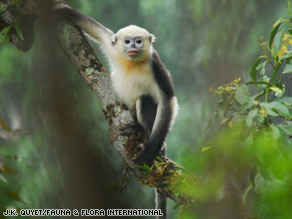
Researchers have discovered a previously unknown group of rare monkeys in the forests of Vietnam.
December 9, 2008

Researchers have discovered a previously unknown group of rare monkeys in the forests of Vietnam.
The Tonkin snub-nosed monkeys were so skittish, researchers captured a photo of only one: an adult male.
Several biologists caught fleeting glimpses of about 15 or 20 Tonkin snub-nosed monkeys in a remote area near the Chinese frontier, the wildlife conservation group Fauna & Flora International told CNN last week. (Fauna and Flora International is the organization that is directly funding Debbie Martyr’s conservation work, and thus indirectly her search for Orang Pendek.)
The “bizarre-looking” monkeys — on the brink of extinction — were so skittish around people that researchers were able to snap a photo of just one of them: an adult male scampering through the trees.
The Tonkin Snub-nosed Langur or Dollman’s Snub-nosed Langur (Rhinopithecus avunculus) is a species of langur endemic to northwestern Vietnam. Sightings of the species have become increasingly rare. The primate was thought to be extinct until the 1990s when a small population was discovered in Na Hang District in Tuyen Quang Province of Vietnam. Heavy poaching for food as well as the wildlife blackmarket and the destruction of habitat are the main reasons why the Tonkin Snub-nosed Langur is on the top 25 list of critically endangered species.
The monkeys were “very sensitive to the presence of people, giving warning signs to one another and fleeing” whenever biologists approached, the group said in a statement.
“It was apparent that the monkeys associated humans with danger — perhaps due to ongoing threats from hunters,” the group said.
So few Tonkin snub-nosed monkeys have survived in the wild that scientists thought until recently that they were extinct. Now they estimate that roughly 200 remain, mainly in parts of northern Vietnam near the Chinese border.
Hunters with a taste for bush meat and the loss of habitat have pushed the Tonkin snub-nosed monkey toward extinction, according to the International Union for the Conservation of Nature.
Fauna & Flora said it is working with a variety of groups to improve the livelihoods and “reduce human pressures on the forest ecosystem” in an effort to safeguard the newly discovered group, which was spotted in a patch of forest in the Quan Ba district of Vietnam’s Ha Giang province.
The sighting thrilled conservation biologist Le Khac Quyet, described by Fauna & Flora as “one of the few people in the world who can claim to be an expert on this mysterious species” and as the person credited with discovering the new group of that species.
“When I saw the Tonkin snub-nosed monkeys … I was overjoyed,” he said in the Fauna & Flora statement.
“There is still time to save this unique species, but with just 200 or so left and threats still strong, we need to act now.”
Thanks ddwindell and many others.
About Loren Coleman
Loren Coleman is one of the world’s leading cryptozoologists, some say “the” leading living cryptozoologist. Certainly, he is acknowledged as the current living American researcher and writer who has most popularized cryptozoology in the late 20th and early 21st centuries.
Starting his fieldwork and investigations in 1960, after traveling and trekking extensively in pursuit of cryptozoological mysteries, Coleman began writing to share his experiences in 1969. An honorary member of Ivan T. Sanderson’s Society for the Investigation of the Unexplained in the 1970s, Coleman has been bestowed with similar honorary memberships of the North Idaho College Cryptozoology Club in 1983, and in subsequent years, that of the British Columbia Scientific Cryptozoology Club, CryptoSafari International, and other international organizations. He was also a Life Member and Benefactor of the International Society of Cryptozoology (now-defunct).
Loren Coleman’s daily blog, as a member of the Cryptomundo Team, served as an ongoing avenue of communication for the ever-growing body of cryptozoo news from 2005 through 2013. He returned as an infrequent contributor beginning Halloween week of 2015.
Coleman is the founder in 2003, and current director of the International Cryptozoology Museum in Portland, Maine.
Filed under Breaking News, Cryptotourism, CryptoZoo News, Cryptozoologists, Cryptozoology, New Species